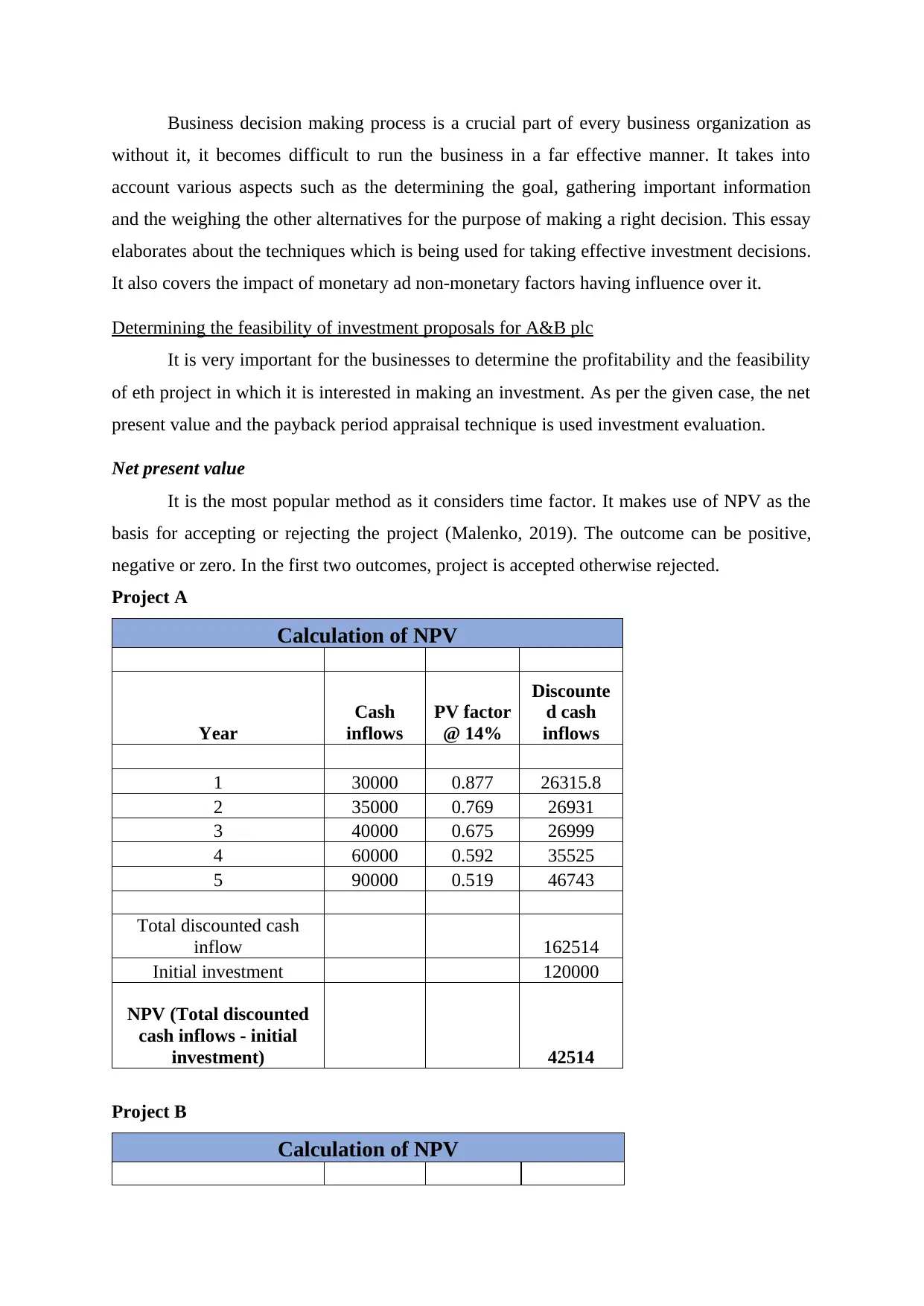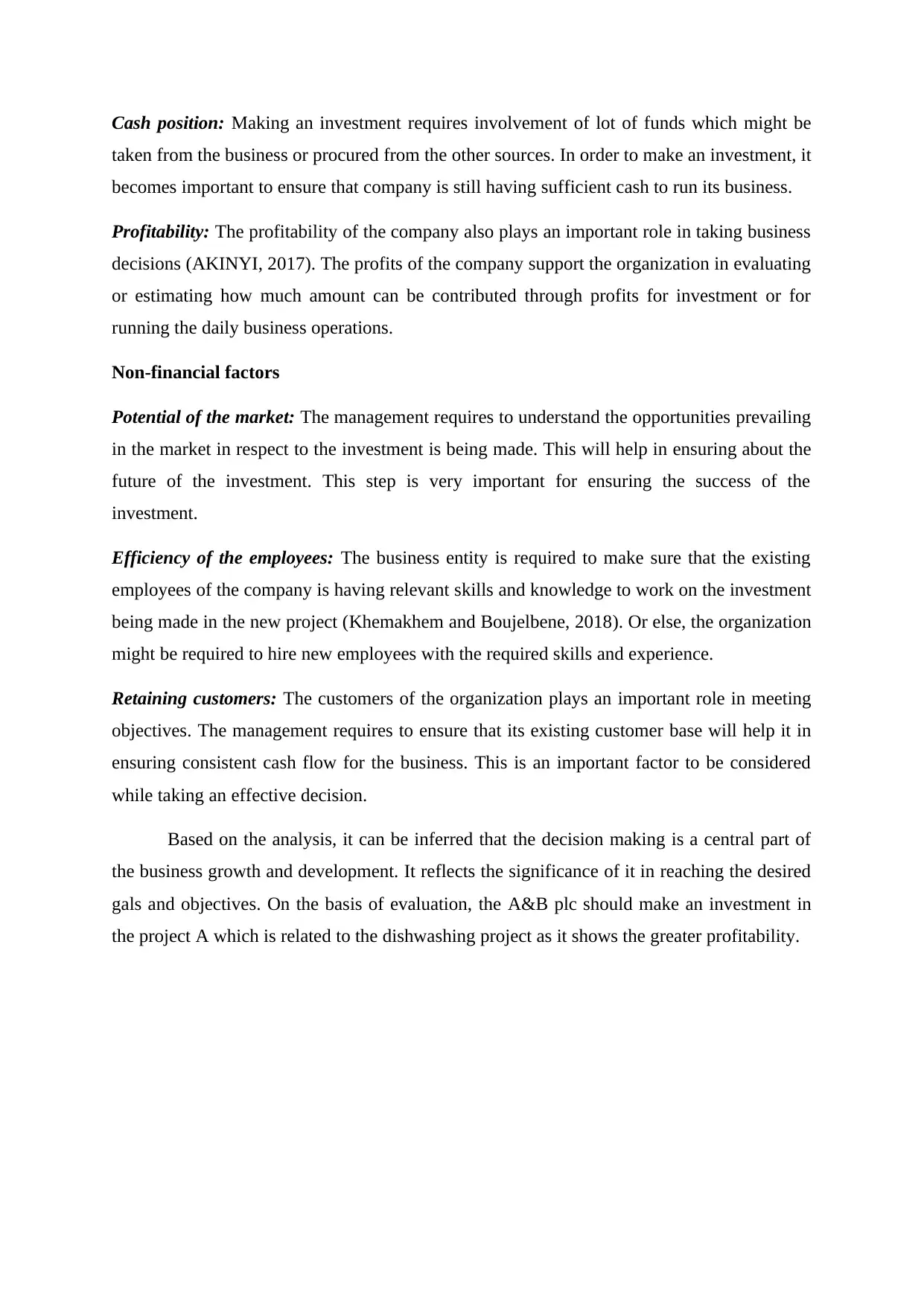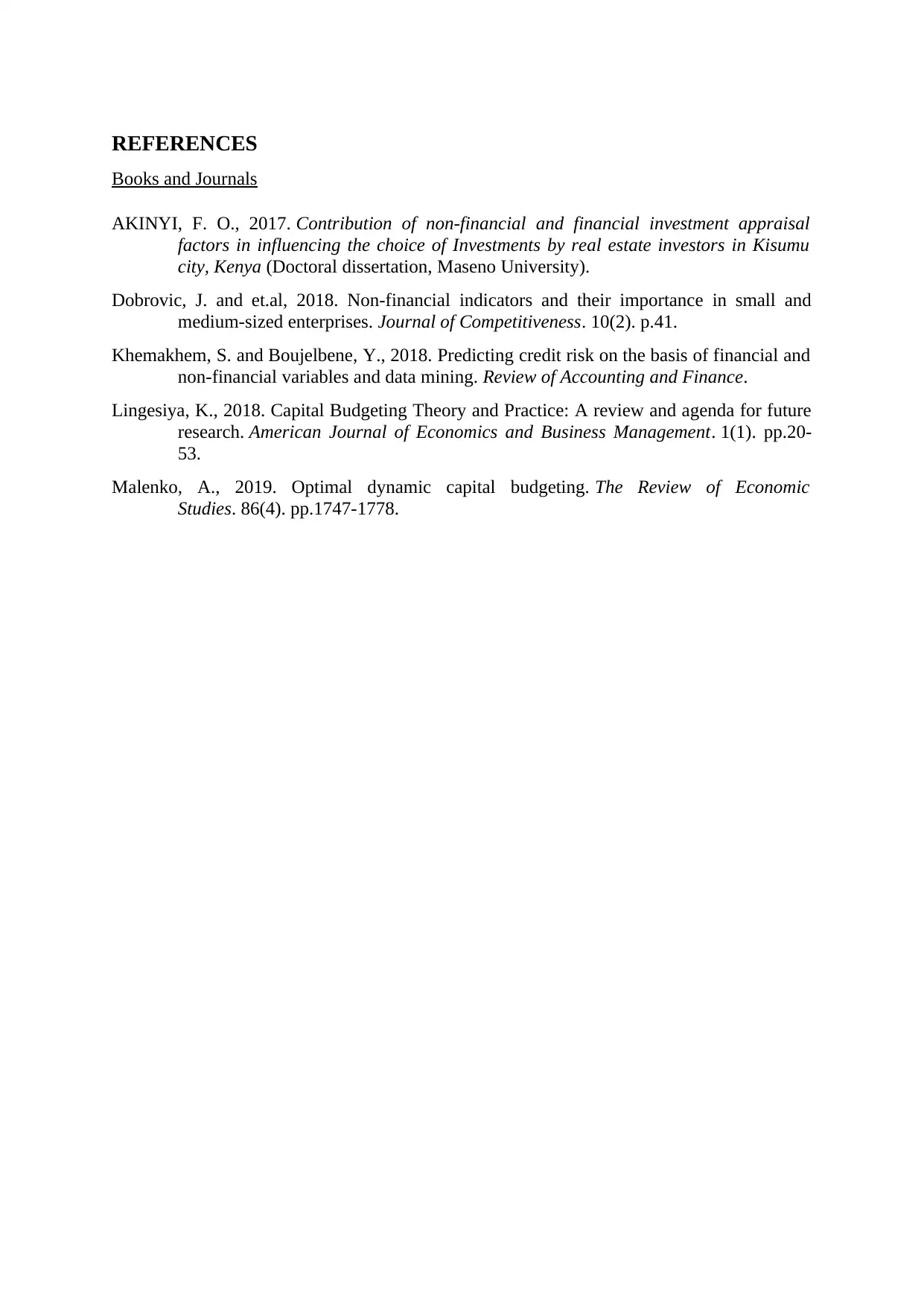Business Decision Making Essay: Investment Feasibility for A&B plc
VerifiedAdded on 2023/01/07
|7
|1299
|32
Essay
AI Summary
This essay delves into the critical process of business decision-making, emphasizing its importance for organizational success. It explores investment appraisal techniques, specifically Net Present Value (NPV) and payback period, using a case study involving A&B plc. The essay calculates and compares the NPV and payback periods for two potential projects, ultimately recommending the project with a higher NPV. It also examines the financial factors (risk, cash position, profitability) and non-financial factors (market potential, employee efficiency, customer retention) that influence investment decisions. The analysis underscores the significance of considering both financial and non-financial aspects for making sound business choices and achieving desired goals and objectives.

Business Decision Making
Paraphrase This Document
Need a fresh take? Get an instant paraphrase of this document with our AI Paraphraser

TABLE OF CONTENTS
Determining the feasibility of investment proposals for A&B plc........................................3
Factor to be considered at the time of making financial decisions........................................5
REFERENCES...........................................................................................................................7
Determining the feasibility of investment proposals for A&B plc........................................3
Factor to be considered at the time of making financial decisions........................................5
REFERENCES...........................................................................................................................7

Business decision making process is a crucial part of every business organization as
without it, it becomes difficult to run the business in a far effective manner. It takes into
account various aspects such as the determining the goal, gathering important information
and the weighing the other alternatives for the purpose of making a right decision. This essay
elaborates about the techniques which is being used for taking effective investment decisions.
It also covers the impact of monetary ad non-monetary factors having influence over it.
Determining the feasibility of investment proposals for A&B plc
It is very important for the businesses to determine the profitability and the feasibility
of eth project in which it is interested in making an investment. As per the given case, the net
present value and the payback period appraisal technique is used investment evaluation.
Net present value
It is the most popular method as it considers time factor. It makes use of NPV as the
basis for accepting or rejecting the project (Malenko, 2019). The outcome can be positive,
negative or zero. In the first two outcomes, project is accepted otherwise rejected.
Project A
Calculation of NPV
Year
Cash
inflows
PV factor
@ 14%
Discounte
d cash
inflows
1 30000 0.877 26315.8
2 35000 0.769 26931
3 40000 0.675 26999
4 60000 0.592 35525
5 90000 0.519 46743
Total discounted cash
inflow 162514
Initial investment 120000
NPV (Total discounted
cash inflows - initial
investment) 42514
Project B
Calculation of NPV
without it, it becomes difficult to run the business in a far effective manner. It takes into
account various aspects such as the determining the goal, gathering important information
and the weighing the other alternatives for the purpose of making a right decision. This essay
elaborates about the techniques which is being used for taking effective investment decisions.
It also covers the impact of monetary ad non-monetary factors having influence over it.
Determining the feasibility of investment proposals for A&B plc
It is very important for the businesses to determine the profitability and the feasibility
of eth project in which it is interested in making an investment. As per the given case, the net
present value and the payback period appraisal technique is used investment evaluation.
Net present value
It is the most popular method as it considers time factor. It makes use of NPV as the
basis for accepting or rejecting the project (Malenko, 2019). The outcome can be positive,
negative or zero. In the first two outcomes, project is accepted otherwise rejected.
Project A
Calculation of NPV
Year
Cash
inflows
PV factor
@ 14%
Discounte
d cash
inflows
1 30000 0.877 26315.8
2 35000 0.769 26931
3 40000 0.675 26999
4 60000 0.592 35525
5 90000 0.519 46743
Total discounted cash
inflow 162514
Initial investment 120000
NPV (Total discounted
cash inflows - initial
investment) 42514
Project B
Calculation of NPV
⊘ This is a preview!⊘
Do you want full access?
Subscribe today to unlock all pages.

Trusted by 1+ million students worldwide

Year
Cash
inflows
PV factor
@ 14%
Discounte
d cash
inflows
1 40000 0.877 35087.7
2 45000 0.769 34626
3 50000 0.675 33749
4 75000 0.592 44406
5 80000 0.519 41549
Total discounted cash
inflow 189418
Initial investment 150000
NPV (Total discounted
cash inflows - initial
investment) 39418
The net present value of project A is £42514 and that of project B is £39418 which
indicates that the project A should be accepted as it is having greater NPV in contrast to the
other one.
Payback period
This method helps in determining the expected amount of time it will take in order to
return the amount invested initially in the form of cash inflow (Lingesiya, 2018). It is useful
in comparing two or more project and that project is selected which is having the lower or
shorter PBP.
Project A
Calculation of Payback period
Year
Total cash
flow
Cumulative cash
flow
0 -120000 -120000
1 30000 -90000
2 35000 -55000
3 40000 -15000
4 60000 45000
5 90000 135000
Payback
period (PBP) 3.25 years
Project B
Cash
inflows
PV factor
@ 14%
Discounte
d cash
inflows
1 40000 0.877 35087.7
2 45000 0.769 34626
3 50000 0.675 33749
4 75000 0.592 44406
5 80000 0.519 41549
Total discounted cash
inflow 189418
Initial investment 150000
NPV (Total discounted
cash inflows - initial
investment) 39418
The net present value of project A is £42514 and that of project B is £39418 which
indicates that the project A should be accepted as it is having greater NPV in contrast to the
other one.
Payback period
This method helps in determining the expected amount of time it will take in order to
return the amount invested initially in the form of cash inflow (Lingesiya, 2018). It is useful
in comparing two or more project and that project is selected which is having the lower or
shorter PBP.
Project A
Calculation of Payback period
Year
Total cash
flow
Cumulative cash
flow
0 -120000 -120000
1 30000 -90000
2 35000 -55000
3 40000 -15000
4 60000 45000
5 90000 135000
Payback
period (PBP) 3.25 years
Project B
Paraphrase This Document
Need a fresh take? Get an instant paraphrase of this document with our AI Paraphraser

Calculation of Payback period
Year
Total cash
flow
Cumulative cash
flow
0 -150000 -150000
1 40000 -110000
2 45000 -65000
3 50000 -15000
4 75000 60000
5 80000 140000
Payback
period (PBP) 3.2 years
The payback period of project A and project B is same which means that company can invest
in any of the two projects.
Since, the PBP of the project is same so the final decision lands at the NPV. The NPV
of project A is greater which makes it more favourable for the purpose of investment. Also,
NPV takes in to consideration time factor which is not so in the case of PBP. In PBP method,
cash flow after break eve point is completely ignored which might lead to inaccurate
decision. But there a drawback of NPV as well, as it considers the discounting rate for
determining the present value which is decided by the management and any error to it leads
to wrong outcome and wrong decision making.
Factor to be considered at the time of making financial decisions
For undertaking any decision, it is imperative for the management to not only focus
on the financial factors but also on the non-financial factors as well. These factors have a
higher significance in decision making process of the investors and the stakeholders of the
company. A complete description is stated below.
Financial factors
Risk involvement: There is always so sort of risk involved in every investment but the
degree of it depends upon the various other aspects (Dobrovic and et.al, 2018). Therefore, the
finance manager of the organization requires to undertake extensive analysis on account of
risk and cost involved and its impact over the business operation and profitability.
Year
Total cash
flow
Cumulative cash
flow
0 -150000 -150000
1 40000 -110000
2 45000 -65000
3 50000 -15000
4 75000 60000
5 80000 140000
Payback
period (PBP) 3.2 years
The payback period of project A and project B is same which means that company can invest
in any of the two projects.
Since, the PBP of the project is same so the final decision lands at the NPV. The NPV
of project A is greater which makes it more favourable for the purpose of investment. Also,
NPV takes in to consideration time factor which is not so in the case of PBP. In PBP method,
cash flow after break eve point is completely ignored which might lead to inaccurate
decision. But there a drawback of NPV as well, as it considers the discounting rate for
determining the present value which is decided by the management and any error to it leads
to wrong outcome and wrong decision making.
Factor to be considered at the time of making financial decisions
For undertaking any decision, it is imperative for the management to not only focus
on the financial factors but also on the non-financial factors as well. These factors have a
higher significance in decision making process of the investors and the stakeholders of the
company. A complete description is stated below.
Financial factors
Risk involvement: There is always so sort of risk involved in every investment but the
degree of it depends upon the various other aspects (Dobrovic and et.al, 2018). Therefore, the
finance manager of the organization requires to undertake extensive analysis on account of
risk and cost involved and its impact over the business operation and profitability.

Cash position: Making an investment requires involvement of lot of funds which might be
taken from the business or procured from the other sources. In order to make an investment, it
becomes important to ensure that company is still having sufficient cash to run its business.
Profitability: The profitability of the company also plays an important role in taking business
decisions (AKINYI, 2017). The profits of the company support the organization in evaluating
or estimating how much amount can be contributed through profits for investment or for
running the daily business operations.
Non-financial factors
Potential of the market: The management requires to understand the opportunities prevailing
in the market in respect to the investment is being made. This will help in ensuring about the
future of the investment. This step is very important for ensuring the success of the
investment.
Efficiency of the employees: The business entity is required to make sure that the existing
employees of the company is having relevant skills and knowledge to work on the investment
being made in the new project (Khemakhem and Boujelbene, 2018). Or else, the organization
might be required to hire new employees with the required skills and experience.
Retaining customers: The customers of the organization plays an important role in meeting
objectives. The management requires to ensure that its existing customer base will help it in
ensuring consistent cash flow for the business. This is an important factor to be considered
while taking an effective decision.
Based on the analysis, it can be inferred that the decision making is a central part of
the business growth and development. It reflects the significance of it in reaching the desired
gals and objectives. On the basis of evaluation, the A&B plc should make an investment in
the project A which is related to the dishwashing project as it shows the greater profitability.
taken from the business or procured from the other sources. In order to make an investment, it
becomes important to ensure that company is still having sufficient cash to run its business.
Profitability: The profitability of the company also plays an important role in taking business
decisions (AKINYI, 2017). The profits of the company support the organization in evaluating
or estimating how much amount can be contributed through profits for investment or for
running the daily business operations.
Non-financial factors
Potential of the market: The management requires to understand the opportunities prevailing
in the market in respect to the investment is being made. This will help in ensuring about the
future of the investment. This step is very important for ensuring the success of the
investment.
Efficiency of the employees: The business entity is required to make sure that the existing
employees of the company is having relevant skills and knowledge to work on the investment
being made in the new project (Khemakhem and Boujelbene, 2018). Or else, the organization
might be required to hire new employees with the required skills and experience.
Retaining customers: The customers of the organization plays an important role in meeting
objectives. The management requires to ensure that its existing customer base will help it in
ensuring consistent cash flow for the business. This is an important factor to be considered
while taking an effective decision.
Based on the analysis, it can be inferred that the decision making is a central part of
the business growth and development. It reflects the significance of it in reaching the desired
gals and objectives. On the basis of evaluation, the A&B plc should make an investment in
the project A which is related to the dishwashing project as it shows the greater profitability.
⊘ This is a preview!⊘
Do you want full access?
Subscribe today to unlock all pages.

Trusted by 1+ million students worldwide

REFERENCES
Books and Journals
AKINYI, F. O., 2017. Contribution of non-financial and financial investment appraisal
factors in influencing the choice of Investments by real estate investors in Kisumu
city, Kenya (Doctoral dissertation, Maseno University).
Dobrovic, J. and et.al, 2018. Non-financial indicators and their importance in small and
medium-sized enterprises. Journal of Competitiveness. 10(2). p.41.
Khemakhem, S. and Boujelbene, Y., 2018. Predicting credit risk on the basis of financial and
non-financial variables and data mining. Review of Accounting and Finance.
Lingesiya, K., 2018. Capital Budgeting Theory and Practice: A review and agenda for future
research. American Journal of Economics and Business Management. 1(1). pp.20-
53.
Malenko, A., 2019. Optimal dynamic capital budgeting. The Review of Economic
Studies. 86(4). pp.1747-1778.
Books and Journals
AKINYI, F. O., 2017. Contribution of non-financial and financial investment appraisal
factors in influencing the choice of Investments by real estate investors in Kisumu
city, Kenya (Doctoral dissertation, Maseno University).
Dobrovic, J. and et.al, 2018. Non-financial indicators and their importance in small and
medium-sized enterprises. Journal of Competitiveness. 10(2). p.41.
Khemakhem, S. and Boujelbene, Y., 2018. Predicting credit risk on the basis of financial and
non-financial variables and data mining. Review of Accounting and Finance.
Lingesiya, K., 2018. Capital Budgeting Theory and Practice: A review and agenda for future
research. American Journal of Economics and Business Management. 1(1). pp.20-
53.
Malenko, A., 2019. Optimal dynamic capital budgeting. The Review of Economic
Studies. 86(4). pp.1747-1778.
1 out of 7
Related Documents
Your All-in-One AI-Powered Toolkit for Academic Success.
+13062052269
info@desklib.com
Available 24*7 on WhatsApp / Email
![[object Object]](/_next/static/media/star-bottom.7253800d.svg)
Unlock your academic potential
Copyright © 2020–2025 A2Z Services. All Rights Reserved. Developed and managed by ZUCOL.





